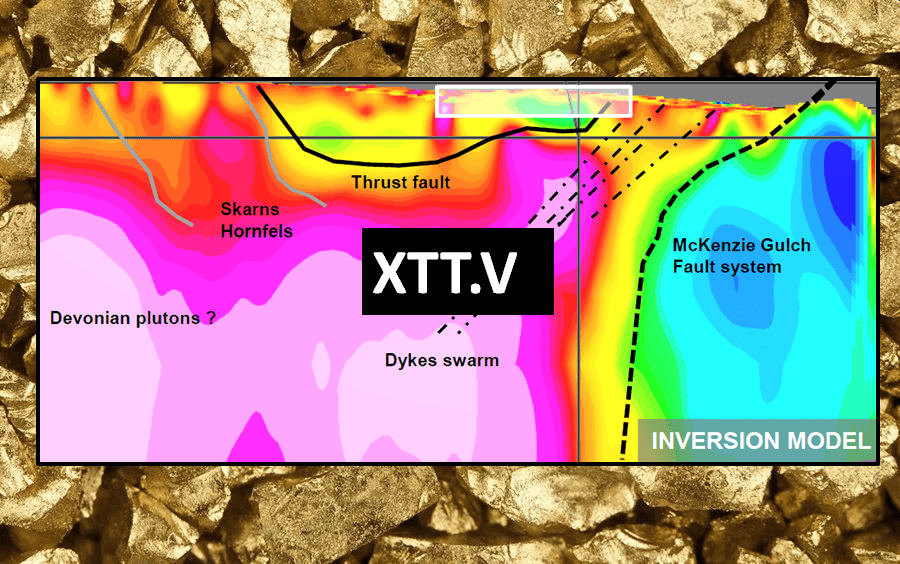On September 21, 2020, X-Terra Resources (XTT.V) released the results of its geochemical sampling program along with the additional Induced Polarization (IP) ground geophysics.
Geochemical sampling involves taking a small portion of the Earth to determine its mineralogy, composition and grade with the expectation that the results will be representative of the surrounding area.
Induced Polarization is an exploration method involving the measurement of the slow decay of voltage in the ground following the cessation of an excitation current pulse.
IP has a good track method of identifying minerals, including gold, copper, and silver – because they have “huge IP signatures.”
Geochemical sampling and IP are often deployed to create drill targets.
“X-Terra’s 280 square kilometer Grog and Northwest projects, located along the McKenzie Gulch Fault in Northeastern New Brunswick, delivered a new gold discovery in recent weeks from an 11-hole drilling campaign staged earlier this year,” wrote Equity Guru’s Greg Nolan on June 22, 2020.

“The discovery at Grog is in hole GRG-20-012 which tagged 0.41 g/t Au over 36 meters (including 0.46 g/t Au over 31 meters and 7.59 g/t Au over 0.6 meters) at a vertical depth of 81 meters,” continued Nolan.
“No, the grade isn’t especially fat or sexy, but it’s a broad intercept of mineralization suggesting a (potentially) large mineralized system lurking in the project’s subsurface layers.
Thus far, GRG-20-012 is the only hole drilled into this newly identified structure.
It’s important to understand that epithermal systems are often defined by sub-one-gram material. It’s the scale and near-surface nature of the mineralization that moves the needle for these types of deposits.” – End of Nolan
Nolan is pointing out is that an economic deposit of this type can not be buried five kilometers beneath the earth’s surface. The depth of the deposit radically affects its financial viability.
To get financed, the project will need to generate cash quickly – that means scooping out metals fairly close to the surface.
Highlights:
- Increased the size of the original drill program (11 holes) to a total of 20 holes
- Rim Target: 4 shallow holes of 100 metres
- Grog Target: 16 holes ranging from 150 metres to 300 metres
- Gold-in-soil anomalies above the Rim vein
- 4 other gold occurrences
- Stacking possibility of additional gold bearing veins at the Rim target.
The Grog and Northwest property is comprised of 36 claims totalling approximately 245 square kilometres, located in the Restigouche County in northwestern New Brunswick and located approximately 100 kilometres west of the Bathurst mining camp.
At Grog, a total of 128 geochemical samples were collected over three parallel lines. The objective was to confirm the position of the Grog gold bearing structure and to test and confirm the possibility of parallel signatures.
Examples of pathfinder minerals that are geochemical indicators for gold include: silver, arsenic, tellurium antimony and selenium.
The XTT results yielded values of up to 36 ppb gold, and “pathfinder elements” 291 ppm Arsenic and 25.8 ppm Antimony.
Four lines of IP ground geophysics were also completed, totalling 5-line kilometres. XTT believes that the overall Grog footprint can be extended five (5) kilometres north-south and two (2) kilometres east-west.
“The correlation obtained during this phase of works between low mag, high resistivity and gold-arsenic-anomaly at the margin can be considered a significant step up in our understanding of the Grog system.” stated Michael Ferreira, President and CEO of X-Terra, “Not only was the kilometric strike length of the known gold system reached and confirmed by a common signature, but our hypothesis was validated that two other parallel trends of the same orientation and thickness creating a 5 km2 target. This threshold was an important step to reach considering that, this scale is widely accepted as precedent for exploring a deposit of a significant size.”

At Northwest, the Rim vein showing has finally been targeted for a first ever drill test on the Northwest property.
Twenty-four soil samples were collected on one 600 metres long line using 25 metres spacing between samples. The objective of the survey was to test the stacking possibility of parallel veins to Rim by sampling perpendicular to the vein orientation.
The results yielded five samples that identified as distinct gold-in-soil anomalies, including one directly above the Rim vein.
The drill plan for this target includes four shallow holes of 100 metres, which is designed with the goal of testing the down dip projection of soil anomalies and identify the possibility of additional gold bearing quartz veins.

“The geochemical and IP programs were designed to further validate targets for the 2nd drill program at the Grog epithermal system,” stated XTT, “and to evaluate the first ever drilling over the high-grade Rim vein target at Northwest.
- Lukas Kane
Full Disclosure: X-Terra is an Equity Guru marketing client.


Leave a Reply